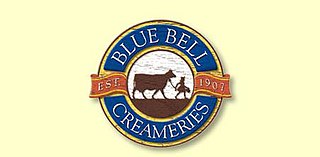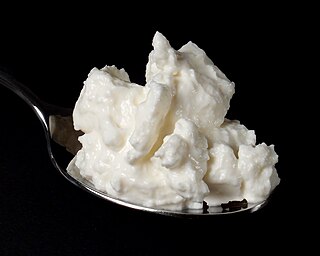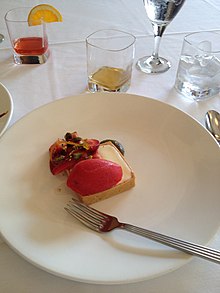
The cuisine of the Southern United States encompasses diverse food traditions of several subregions, including Tidewater, Appalachian, Ozarks, Lowcountry, Cajun, Creole, and Floribbean cuisine. In recent history, elements of Southern cuisine have spread to other parts of the United States, influencing other types of American cuisine.

Louisiana Creole cuisine is a style of cooking originating in Louisiana, United States, which blends West African, French, Spanish, and Native American influences, as well as influences from the general cuisine of the Southern United States.

Pralines are confections containing nuts – usually almonds, pecans and hazelnuts – and sugar. Cream is a common third ingredient.

Buttermilk is a fermented dairy drink. Traditionally, it was the liquid left behind after churning butter out of cultured cream. As most modern butter in western countries is not made with cultured cream but uncultured sweet cream, most modern buttermilk in western countries is cultured separately. It is common in warm climates where unrefrigerated milk sours quickly.

The Pennsylvania State University Creamery, also known as the Penn State Berkey Creamery or just The Creamery, is a producer and vendor of ice cream, sherbet, and cheese, all made through the Department of Food Science in the College of Agricultural Sciences of the Pennsylvania State University. It is the largest university creamery in the United States, using approximately 4.5 million pounds of milk annually, approximately 70% of which comes from a 210-cow herd at the university's Dairy Production Research Center and the rest local milk suppliers, and selling 750,000 hand-dipped ice cream cones per year. Offering over 100 ice cream flavors made with a butterfat content of 14.1% and ingredients from around the country and the world, the Creamery's ice cream is enjoyed by many students and alumni every day.

Blue Bell Creameries is an American food company that manufactures ice cream. It was founded in 1907 in Brenham, Texas. For much of its early history, the company manufactured both ice cream and butter locally. In the mid-20th century, it abandoned butter production and expanded to the entire state of Texas and soon much of the Southern United States. The company's corporate headquarters are located at the "Little Creamery" in Brenham, Texas. Since 1919, it has been in the hands of the Kruse family. As of 2015, Blue Bell was the #2 selling ice cream manufacturer in the United States.

A creamery is a place where milk and cream are processed and where butter and cheese is produced. Cream is separated from whole milk; pasteurization is done to the skimmed milk and cream separately. Whole milk for sale has had some cream returned to the skimmed milk.

Kashk, qurut, chortan, or aaruul and khuruud is a range of dairy products popular in Middle Eastern cuisine, Caucasian cuisine, and Central Asian cuisine. Kashk is made from strained yogurt, drained buttermilk or drained sour milk by shaping it and letting it dry. It can be made in a variety of forms, like rolled into balls, sliced into strips, and formed into chunks.

Ostkaka, ost meaning "cheese" and kaka meaning "cake" in Swedish, also known as Swedish cheesecake or Swedish curd cake, is a Swedish dessert that has its roots in two different parts of Sweden, Hälsingland and Småland, though there are some differences between ostkaka from Hälsingland resembling halloumi in texture, and the soft-grained ostkaka from Småland.

Prairie Farms Dairy is a dairy cooperative founded in Carlinville, Illinois, and now headquartered in Edwardsville, Illinois, a suburb of St. Louis. As a dairy cooperative, Prairie Farms receives milk from producers and converts it into many different products, including cheese, butter, ice cream, sour cream, cottage cheese, various dips, yogurt, and fluid milk. Prairie Farms also produces and sells juices, flavored drinks, and pre-made iced tea.

Brown's Velvet Dairy, now Brown's Dairy, is a historic business in the Central City section of New Orleans, Louisiana, USA. It opened in 1905.

The cuisine of New Orleans encompasses common dishes and foods in New Orleans, Louisiana. It is perhaps the most distinctively recognized regional cuisine in the United States. Some of the dishes originated in New Orleans, while others are common and popular in the city and surrounding areas, such as the Mississippi River Delta and southern Louisiana. The cuisine of New Orleans is heavily influenced by Creole cuisine, Cajun cuisine, and soul food. Later on, due to immigration, Italian cuisine and Sicilian cuisine also has some influence on the cuisine of New Orleans. Seafood also plays a prominent part in the cuisine. Dishes invented in New Orleans include po' boy and muffuletta sandwiches, oysters Rockefeller and oysters Bienville, pompano en papillote, and bananas Foster, among others.

A sno-ball is a confection made with finely shaved ice and flavored sugar syrup. Commonly confused with the snow cone, the ice of a sno-ball is fine and fluffy; while a snow cone's ice is coarse, crunchy, and granular. Moreover, whereas in a snow cone the flavored syrup sinks to the bottom of the cup, in a sno-ball the ice absorbs the syrup.

Kemps is an American dairy company located in St. Paul, Minnesota. It has been a subsidiary of Dairy Farmers of America since being purchased in 2011 from HP Hood LLC. Dairy Farmers of America is based in Kansas City, Missouri, but Kemps continues to be headquartered in St. Paul. Products provided by the company include milk, cottage cheese, half and half, egg nog, cream, juices, sour cream, chip dips, ice cream, yogurt and novelties. Most of these products are sold at grocery stores throughout the midwestern United States, but some are available in other parts of the country as well. Kemps currently operates five manufacturing facilities in Minnesota and Wisconsin.

Quark or quarg is a type of fresh dairy product made from milk. The milk is soured, usually by adding lactic acid bacteria cultures, and strained once the desired curdling is achieved. It can be classified as fresh acid-set cheese. Traditional quark can be made without rennet, but in modern dairies small quantities of rennet are typically added. It is soft, white and unaged, and usually has no salt added.
Pie in American cuisine has roots in English cuisine and has evolved over centuries to adapt to American cultural tastes and ingredients. The creation of flaky pie crust shortened with lard is credited to American innovation.















